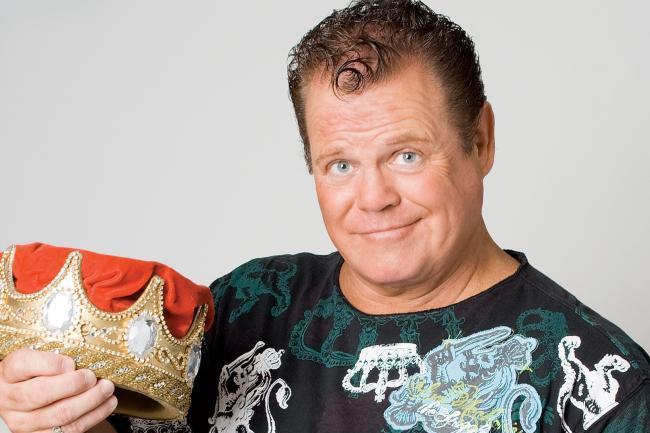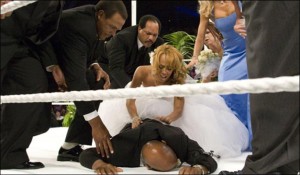When Professional Wrestling Gets Real

Jerry "The King" Lawler
During the September 27, 2007 episode of WWE’s Smackdown, the show’s general manger Teddy Long suffered a heart attack during his planned in-ring wedding. This was part of a storyline. Five years later, on the September 10, 2012 edition of WWE’s Monday Night Raw, ringside and television commentator Jerry Lawler collapsed off-camera and would later be reported as having suffered a heart attack. This, unfortunately, was not a storyline. While both of these events ‘happened,’ only the latter was real – as real as anything could possibly get.
The real heart attack that took place on September 10 of this year left the WWE in a position no other television broadcaster ever has to face. This media production had to not only tell its audience on live broadcast television that a man just had a heart attack, but also convince their audience that a man actually had a heart attack. Before we get into what this all means, let’s take a look at what happened that night.
Jerry Lawler had been at the announce table with fellow commentator Michael Cole as he is almost every episode. These two men ‘call the action’ in the ring, narrating the events to give context and background information to the viewer. During a match, Lawler collapsed at ringside (off-camera) and the announcers went silent. All the home audience could hear was the ambient noise from the arena. After several minutes, Cole began calling the match on his own with no acknowledgement for Lawler’s absence. It was not until two segments later that Cole addressed the audience about the incident:
Professional wrestling has always had a unique relationship with reality, as the fictionalized nature of the performance is tacitly understood by the audience, leading to the assumption that whatever is seen is planned or ‘part of the act.’ How, then, is the audience supposed to react to this news, given the WWE’s constant reification of the idea that everything one sees is a story? The live broadcast gives them little time and resources to not only acknowledge the event, but to clarify its legitimacy. So they state (via Cole): “This is not part of tonight’s entertainment. This has happened… This is a real life situation.” This mantra was restated throughout the remaining 3-hour broadcast, with new details on the situation given each time.
Here one can begin to see the type of situation WWE found itself in. This is a company that operates on the assumption that whatever is seen on their broadcasts is part of a larger performance, a fictitious storyline. However, this unique convention has led to problems in the past. Take, for instance, when real life chairman of WWE Vince McMahon appeared as his ‘character’ Vince McMahon (think Stephen Colbert and ‘Stephen Colbert’) on a Raw broadcast and ‘died’ in a fiery limousine explosion.
While this was meant to be a ‘kayfabe’ event (meaning existing within the fiction of the program), there were possible real life consequences. As a publically traded company, WWE answers not only to their paying customers and fans, but to their stockholders as well. During the ‘McMahon death’ angle, CNBC reporter Darren Rovell questioned if purporting the head of your company has ‘died’ on your company’s official press release and website could be grounds for misleading stockholders. The company’s response:
“It is well known to our shareholders and our viewers that “Mr. McMahon” is a character portrayed by Vincent Kennedy McMahon, the founder and Chairman of World Wrestling Entertainment, Inc.”
Here we see a fascinating example of the WWE acknowledging the artifice of their promotion, citing ‘character’ and ‘story’ as reasons why such an event should not have real world consequences. Examples like this show that for WWE, the scripted segment is the norm, and reality is the exception to the rule, not the other way around. WWE expects viewers to know the fictive nature of the events on-screen, despite constant attempts to undermine their own artifice. Instead of just showing the limo explode on-screen, the storyline crept into all other forms of their media empire: website, press releases, WWE Magazine, and recap shows. Vince McMahon did not make public appearances for weeks during the angle. This is like if an Emmy-nominated actor whose character was killed off the show couldn’t go to the ceremony because the writers wanted to ‘keep the fiction alive.’
Returning to Jerry Lawler’s heart attack, what makes this event so fascinating is how no other television broadcast has to deal with such issues of reality/fiction. Part of this is due to the live nature of the performance, but Saturday Night Live, as an example of another live performance show, would rarely face this problem because they follow certain conventions in terms of content and portrayal. SNL rarely challenges standard expectations and so their audience is trained to easily tell what is a written sketch and what is not. However, WWE’s long history of bucking convention makes this negotiation more difficult, as can be seen with its past use of a heart attack in a storyline mentioned in this article’s opening. When little is off-limits in terms of storytelling fodder and anything can be expected, how can the audience tell when something truly unexpected happens?
Overall, the live fiction program is a rare part of the contemporary television landscape, and this special nature raises particular challenges and negotiations, particularly when it comes to the nature of fiction and reality, the planned and the spontaneous. Professional wrestling not only lives in this tenuous environment, it thrives upon it. However, existing within such a state of tension brings unique challenges with unique solutions.



